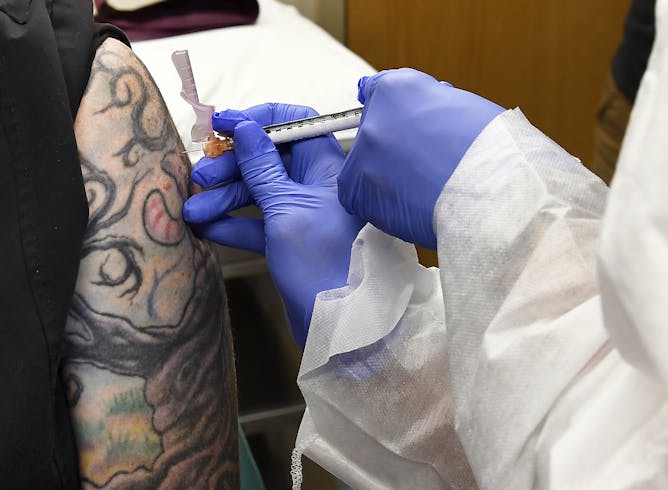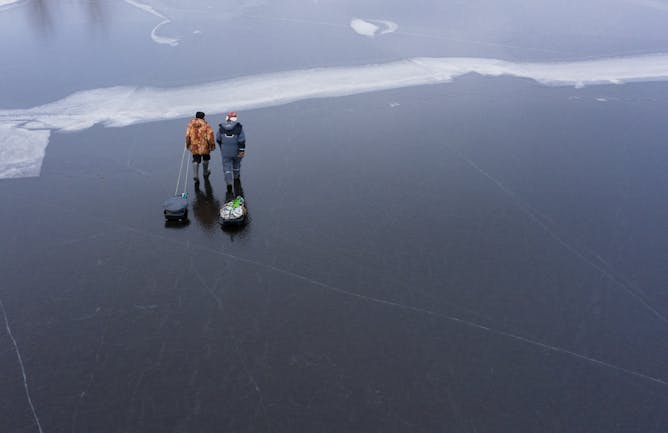|
When Pfizer announced its preliminary COVID-19 vaccine results last week, it provided a ray of hope as the pandemic’s second wave rolled forward. The preliminary data indicated it was over 90 per cent effective. A week later, Moderna announced that its own vaccine’s preliminary results were also very promising, with 95 per cent effectiveness.
Yesterday, Pfizer grabbed the spotlight back by releasing its final results along with two months of safety data: effectiveness of 95 per cent. An application for emergency authorization from the U.S. Food and Drug Administration is in the works. Obviously it would require manufacturing, distribution and administration of the vaccine on a massive scale even if that authorization is successful, but it's definitely good news.
The Pfizer and Moderna vaccines are both mRNA vaccines — a new type of platform that hasn’t been used before. Today in The Conversation Canada, physician scientist Julian Willett of McGill University explains how these mRNA vaccines work, and what they might mean in terms of an eventual return to normal.
Also today:
Regards,
|

A volunteer gets an injection of Moderna’s possible COVID-19 vaccine on July 27, 2020. Moderna announced Nov. 16 that its vaccine is proving highly effective in a major trial.
(AP Photo/Hans Pennink)
Julian Daniel Sunday Willett, McGill University
Two pharma companies have announced early COVID-19 vaccine trial results with over 90 per cent effectiveness. What does that mean for getting back to normal?
|

Why has the Doug Ford government been so reluctant to take action amid the second wave of COVID-19?
THE CANADIAN PRESS/Frank Gunn
Mark Winfield, York University, Canada
Is Ontario Premier Doug Ford's mishandling of the second wave of COVID-19 a byproduct of his pro-business sympathies?
|

Winter drowning rates are highest in countries with strong ice-fishing cultures and temperatures that hover near freezing.
(Shutterstock)
Sapna Sharma, York University, Canada
Winter drownings become more common on warmer days or when rain has fallen on snow, leaving the ice thinner, weaker, and less stable.
|

The extreme intoxication defence is often successful when used, usually in cases involving male violence against women.
(Unsplash)
Amy Swiffen, Concordia University; Naomi Barney Purdie, McGill University
Evidence suggests that the defence of extreme intoxication isn't rarely used, and is often successful in cases involving male violence against women.
|

Isolating prisoners in cells with no contact and little activity over a sustained period of time amounts to torture.
(Shutterstock)
Linda Mussell, Queen's University, Ontario; Marsha Rampersaud, Queen's University, Ontario
While seemingly an alternative to solitary confinement, Structured Intervention Units have been a catastrophic failure, especially for imprisoned people with mental illness.
|

Une étoile filante pendant la pluie de météores des Perséides. Bientôt, des milliers de satellites envahiront le ciel nocturne.
Shutterstock
Samantha Lawler, University of Regina
Les satellites de SpaceX vont peupler le ciel nocturne, ce qui aura une incidence sur notre façon d’observer les étoiles. Et ce n’est que le début des mégaconstellations de satellites privés.
|
COVID-19
|
-
Zoë McLaren, University of Maryland, Baltimore County
COVID-19 cases are skyrocketing across the US. Testing has ramped up over the past few months, but increasing hospitalizations, deaths and test-positivity rates show that the virus is out of control.
|
|
Culture + Society
|
-
Mark Satta, Wayne State University
A philosopher writes about why many of us are feeling tired with the constant onslaught of information coming at us.
|
|
Health
|
-
Adam Taylor, Lancaster University
Everything from hormones to certain heath conditions can affect how we feel.
|
|